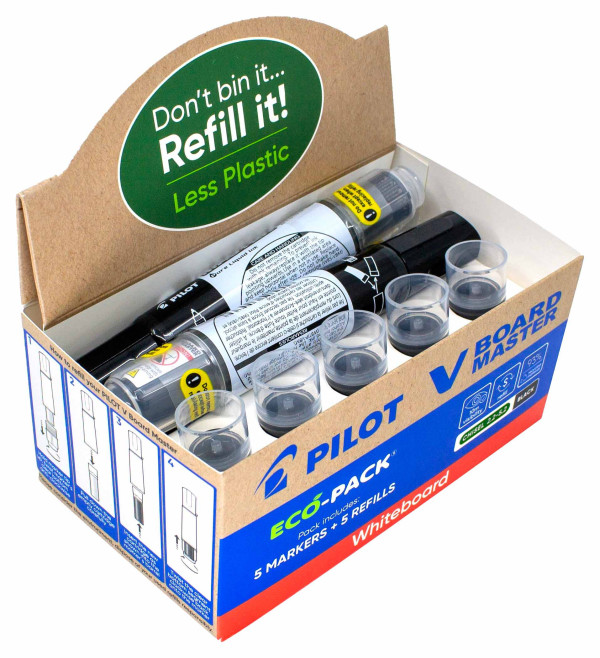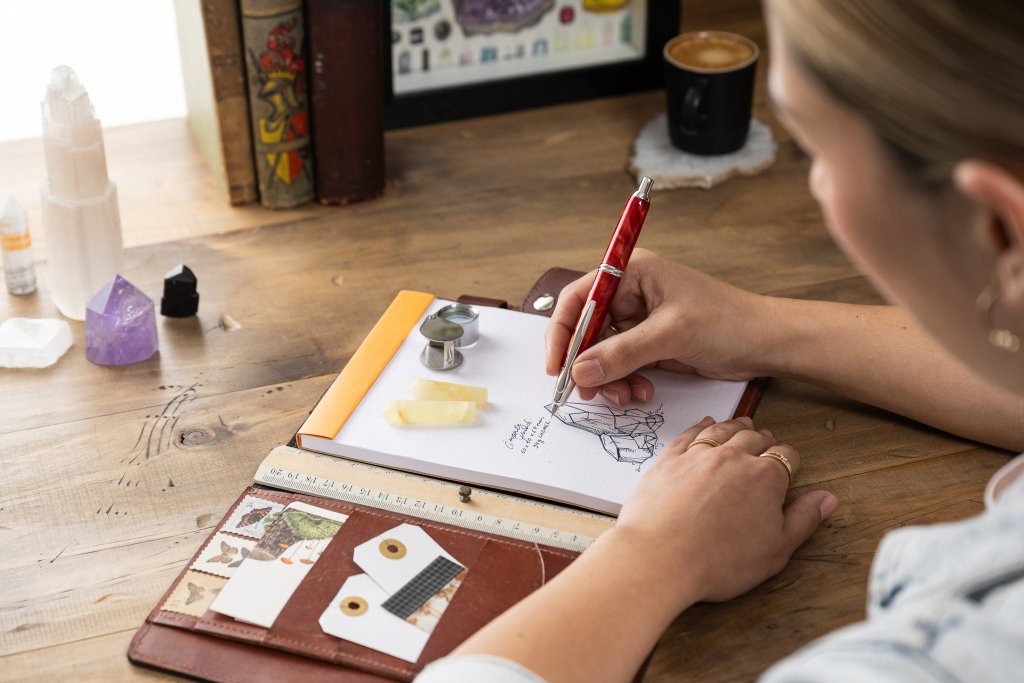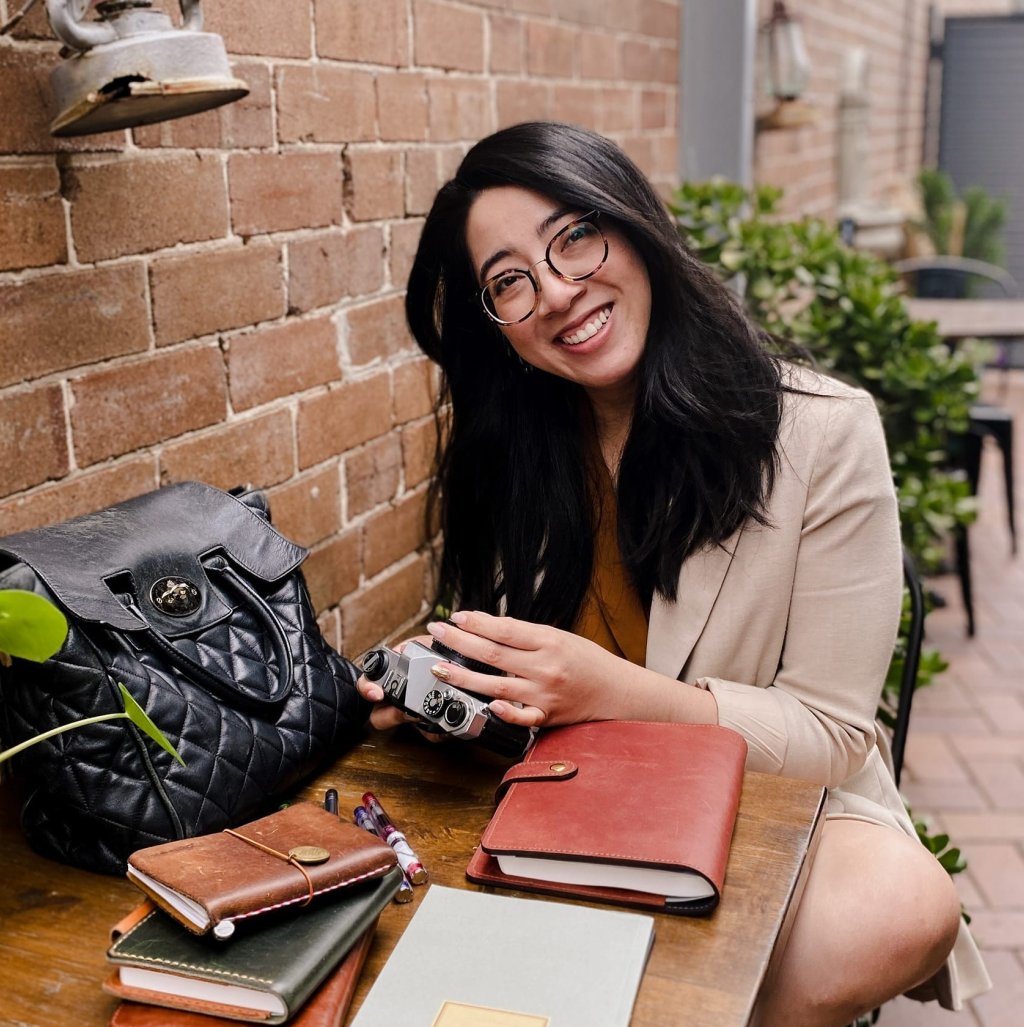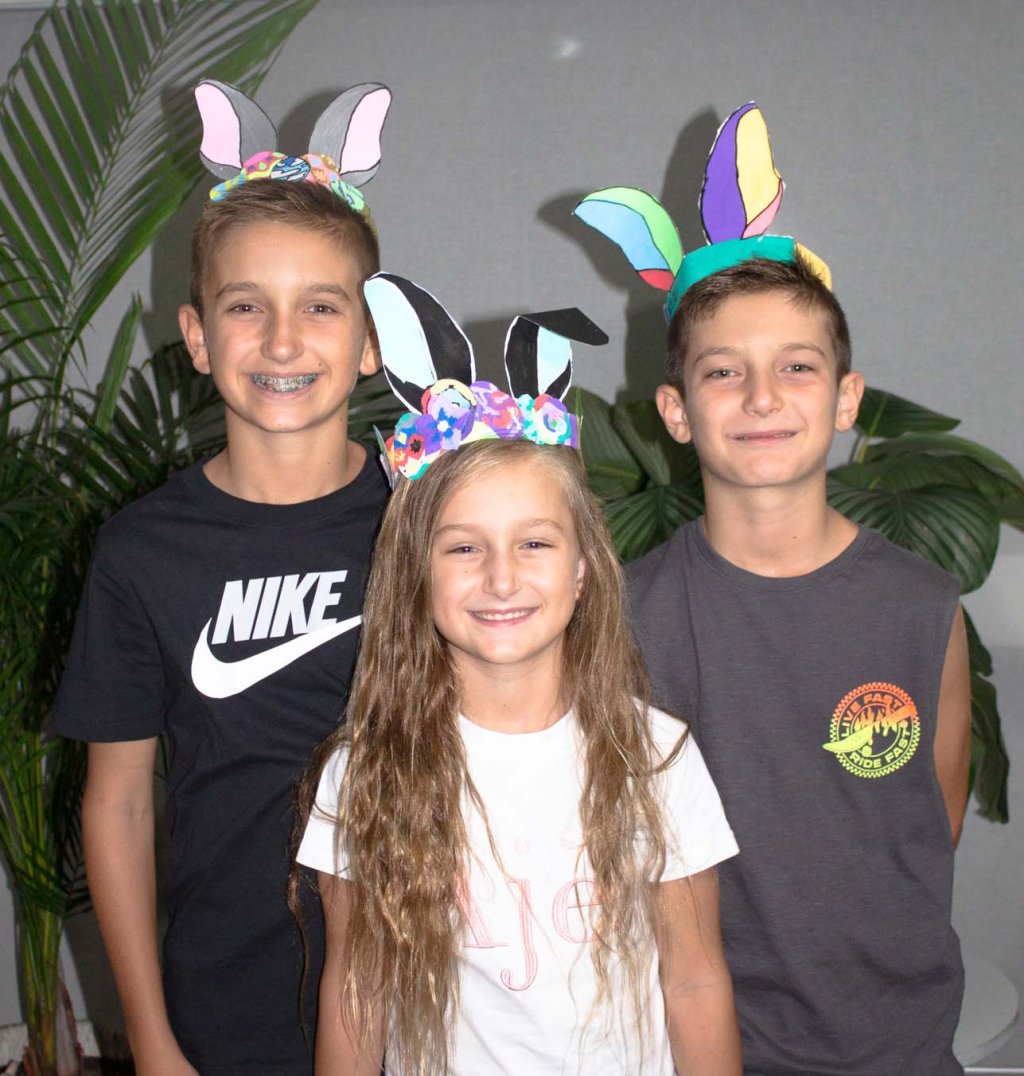Discover the joy of choosing a pen that not only fits your hand but also complements your writing style, with insights on balance, comfort, and the significance of nib options and filling systems.
Learn the importance of ink selection, how it reflects personal expression and improves the writing quality. Embrace the essentials of maintenance and the correct writing techniques to ensure your pen remains a faithful companion for years to come.
Key Takeaways
Step 1: Pen Selection: Choose a fountain pen that matches your style and comfort, focusing on durability, nib options, and ease of use.
Step 2: Ink & Nibs: Explore diverse ink colours and nib sizes to enhance your writing, tailoring your pen to your personal expression.
Step 3: Writing Technique: Master the correct grip, posture, and pressure for smooth writing, alongside the nuances of using a fountain pen.
Maintenance: Keep your pen in optimal condition with regular cleaning and troubleshooting, ensuring its longevity and performance.
Personalisation & Advanced Techniques: Personalise your pen and explore advanced writing techniques like calligraphy for a unique writing experience.
Ink: Your Medium for Self-Expression: Learn how the hue, saturation, and fluidity of your chosen ink can elevate the pleasure of writing and allow your individuality to shine through.
Step 1. Choose Your First Fountain Pen
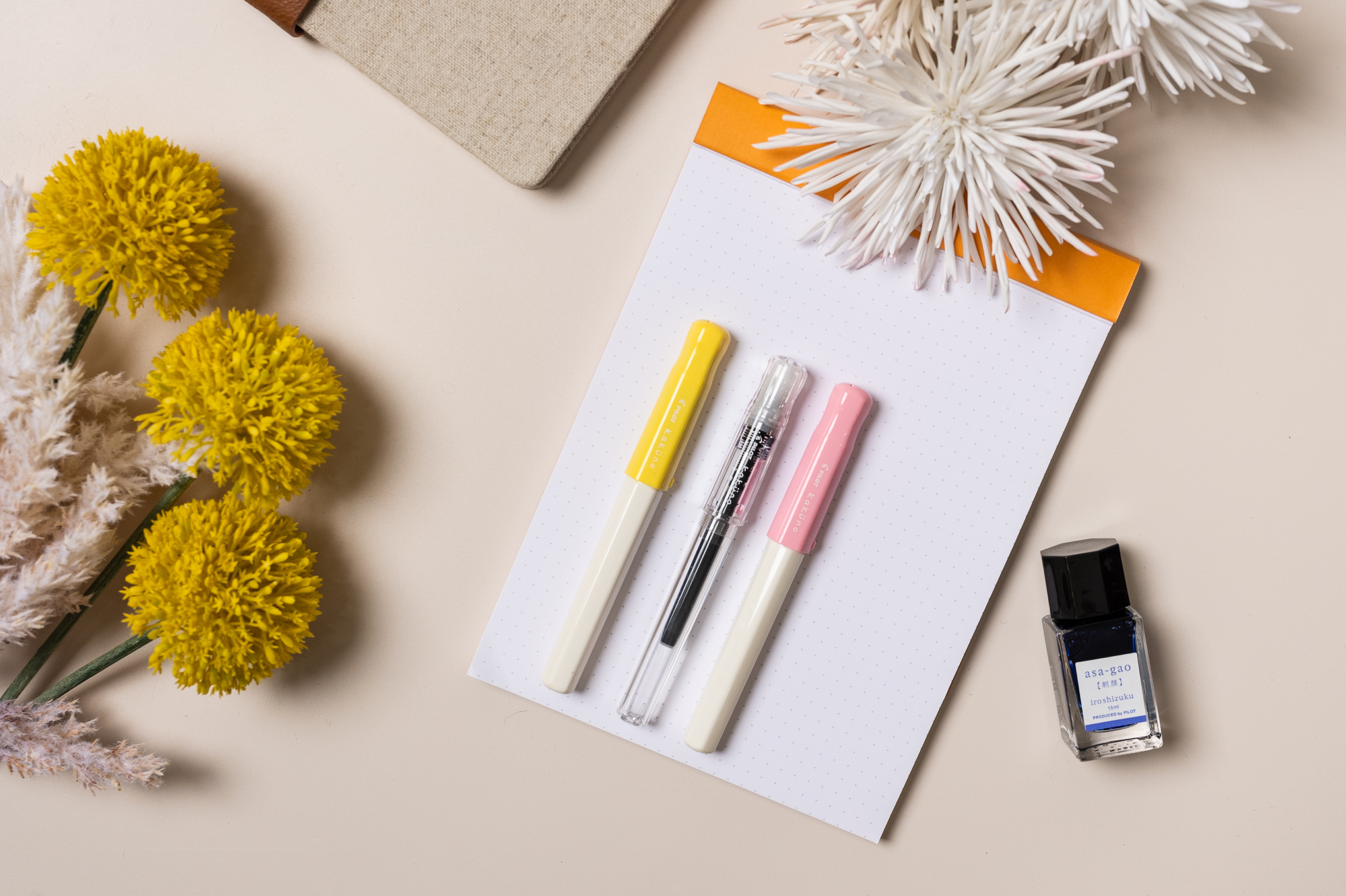
The journey into the world of fountain pen writing starts with choosing your first fountain pen. It’s a personal choice, heavily influenced by factors like durability, comfort, and nib options. After all, this is an instrument you’re likely to use daily, so it should offer a smooth writing experience and enhance the quality of your handwriting.
For beginners, the balance and comfort of a lighter-weight pen with a wider body are essential, especially for extended writing sessions. The PILOT MR1 Classic Fountain and Kakuno Fountain pens, for instance, are favoured among beginners for their balance, comfort, and the availability of different nib sizes. The key is to find a pen that you’ll enjoy using the most, and that will complement your personal writing style and aesthetic preferences.
Finding the Right Size and Fit
When selecting a fountain pen, comfort is paramount. You want a pen that feels natural in your hand, encouraging a proper pen-holding technique to prevent strain. A great fountain pen should feel balanced in your hand, ensuring ease of use and a natural flow of writing.
Finding the correct size and fit of a fountain pen is crucial for comfort and ease of use. After all, a pen that feels right in your hand will make the writing experience more enjoyable and less tiresome.
Understanding Nib Options
The nib is the heart of the fountain pen, and understanding your options is vital to the writing experience. Nib size, such as a fine nib, plays a crucial role in handwriting and the width of the drawn lines. Whether you prefer:
Extra Fine (EF)
Fine (F)
Medium (M)
Broad (B)
Each size caters to a different writing style and preference.
For instance, Fine nibs, provide versatility across various paper qualities and maintain smoothness, making them ideal for individuals with small, clear handwriting. On the other hand, broad nibs release more ink onto the paper and are ideal for those who prefer larger handwriting or calligraphy and want to enjoy the unique characteristics of their ink more. Ultimately, the choice of nib is a personal one, and experimenting with different nib sizes and types can enhance your writing experience.
For a deeper understanding of fountain pen nib options, explore our detailed nib guide: The Anatomy of A Fountain Pen - How to Choose the 'Right' Nib.
Selecting a Filling System
Fountain pens offer several filling system options, each catering to different personal preferences:
Cartridge: Cartridges are the epitome of convenience and portability. They're easy to replace, making them perfect for those on the move. You can easily carry spare cartridges with you, ensuring that you're never caught without ink.
Converter: A converter allows you to enjoy a broader selection of inks, including the vibrant and diverse PILOT iroshizuku range. Converters come in different types, such as Push-type Converters, which are straightforward and easy to use, and Rotary Converters, which offer a more traditional twist-action function. Both types offer the versatility of using bottled inks while maintaining the convenience of a cartridge system, making them a practical choice for those who love to experiment with colours.
Piston: Although piston fillers have a higher ink capacity, they are less convenient compared to cartridges and converters. They require more maintenance, especially if you enjoy changing ink colours often and this system might be less appealing for those who value ease and efficiency over ink volume.
When selecting a fountain pen filling mechanism, consider personal needs such as:
Ink capacity: If frequent refills are a concern, a piston filler's larger capacity might be beneficial, despite its less convenient nature.
Cost: Cartridges are often more economical initially, but the long-term savings from using a converter or piston system with bottled ink can be significant.
Maintenance: If ease of maintenance is a priority, cartridges are the simplest option, while piston systems require more attention.
Performance: The choice of system may influence the writing experience. Cartridges and converters are user-friendly, while pistons appeal to those who enjoy a more hands-on approach.
If you are undecided, fear not! Many PILOT fountain pens and others provide the option to use either convenient cartridges or a converter, offering users the flexibility to switch between the ease of cartridges and the vast selection of bottled inks.
Step 2. Prepare to Write with Your Fountain Pen
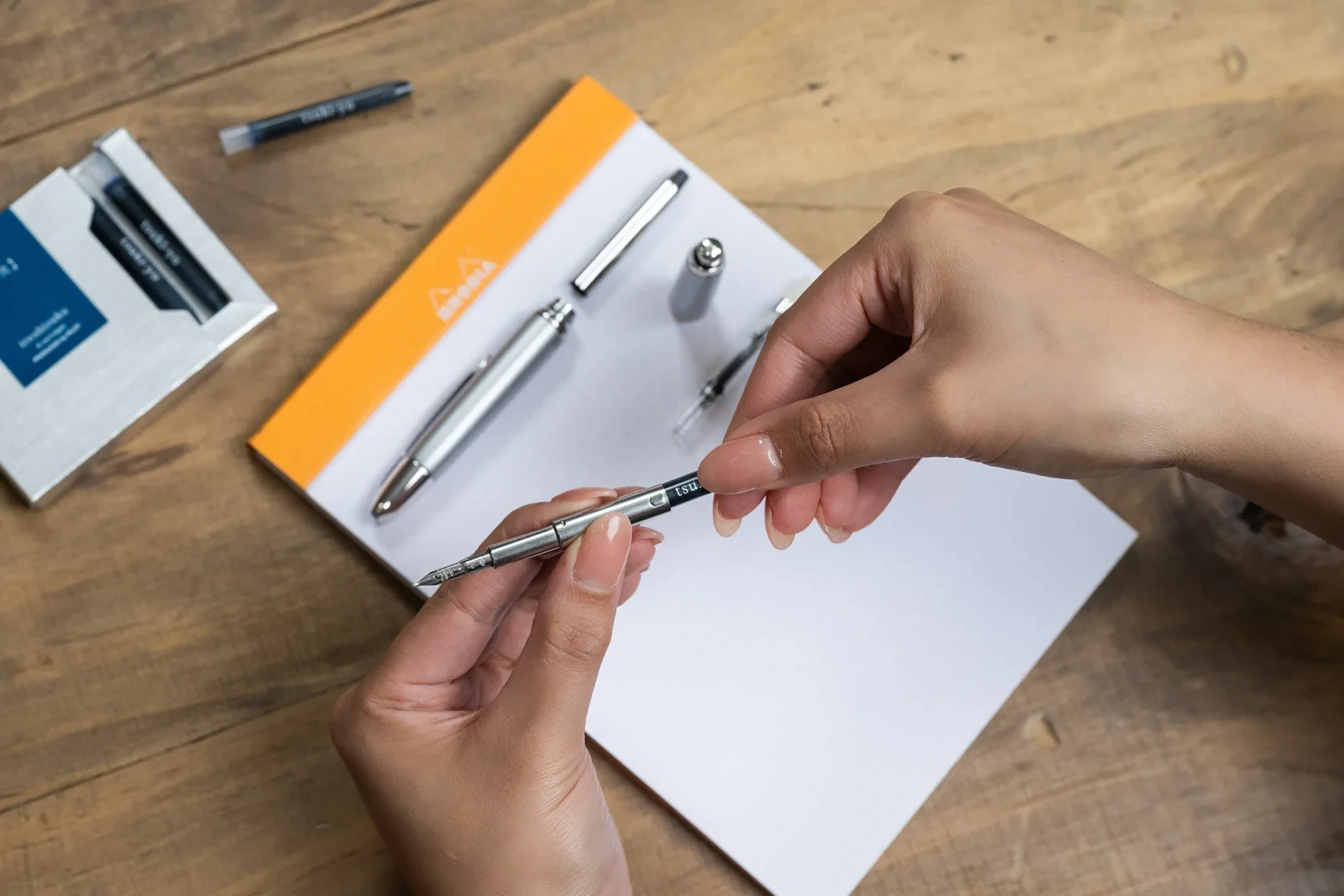 Before you can start writing with your fountain pen, there are a few essential steps to follow:
Before you can start writing with your fountain pen, there are a few essential steps to follow:
Flush the pen to ensure it’s free from manufacturing residues.
Correctly insert the ink cartridge.
Achieve the correct grip and find the sweet spot for optimal ink flow and writing smoothness.
Let’s delve into these steps in more detail.
Inserting the Ink Cartridge or Converter
Ink cartridges come pre-filled and are ready to be inserted into your fountain pen, while converters need to be refilled with ink once they run empty.
Inserting Ink Cartridges
Installing an ink cartridge into your PILOT fountain pen is a simple process. Here are the steps to follow:
Start by unscrewing the pen’s neck while holding the nib upwards.
Push the cartridge straight into the back of the pen’s neck until it pops into place to secure it.
Once inserted, gently squeeze the cartridge a few times to start the ink flow into the nib and continue squeezing until ink appears on the nib tip.
Remember, avoid turning the ink cartridge while inserting it to prevent it from being incorrectly opened.
Inserting Converters
The initial steps for inserting a converter are similarly easy as installing cartridges:
For refilling the converter with ink:
Submerge the nib into the ink so the converter opening is covered.
Depending on the type of converter, either twist the end of a rotary converter or push the plunger of a push-type converter to draw ink into the reservoir.
Wipe excess ink from the nib and grip section.
Screw the pen body back onto the nib section.
Your fountain pen is now ready with the converter and fresh ink.
Achieving the Correct Grip
Achieving the correct grip is vital for a comfortable and controlled writing experience. The tripod grip, where the fountain pen is lightly held between the thumb and forefinger, supported by the middle finger underneath, provides balanced control. The fountain pen should rest on the bottom knuckle of the index finger with fingertips resting on the top of the grip, just before the nib.
Maintaining a firm but gentle grip allows for sufficient control without exerting excessive pressure, preventing potential nib damage and ensuring consistent ink flow.
Finding the Sweet Spot
The ‘sweet spot’ on a fountain pen nib is the angle at which the pen writes smoothly and the ink flows best, typically lying between 40° and 55° relative to the paper. Finding this sweet spot will give you a smooth writing experience.
For a smooth ink flow, hold the fountain pen in a manner that allows the nib to glide gently over the paper, avoiding excess pressure that can impede the ink flow.
Step 3. The Writing Movement: How to Use a Fountain Pen
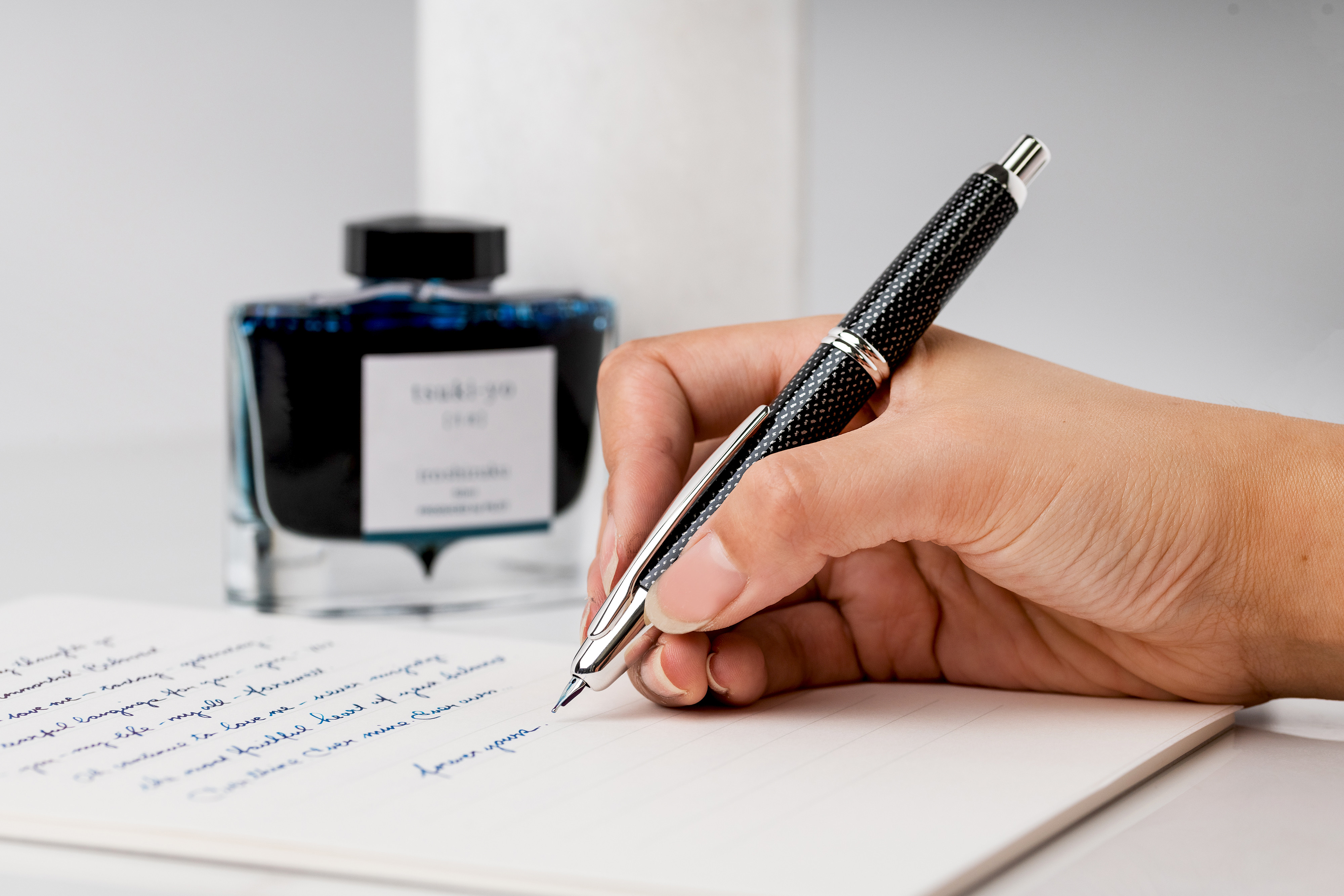 Writing with a fountain pen is more than simply putting pen to paper. It’s about understanding the movements and techniques that can enhance your writing experience. From maintaining proper posture, utilising the correct hand and arm movements, to applying the correct amount of pressure, each aspect plays a crucial role in mastering the art of fountain pen writing.
Writing with a fountain pen is more than simply putting pen to paper. It’s about understanding the movements and techniques that can enhance your writing experience. From maintaining proper posture, utilising the correct hand and arm movements, to applying the correct amount of pressure, each aspect plays a crucial role in mastering the art of fountain pen writing.
Posture and Position
Maintaining proper posture is key for comfortable writing and improved handwriting quality. Make sure to sit up straight at a desk or table with a flat surface. Keep your feet flat on the floor for better posture. This ensures comfort during writing and affects the appearance of handwriting.
Position the paper so it aligns with your forearm, easing the writing motion and improving handwriting quality. The heel of the hand should rest lightly on the writing surface, supporting the weight of the forearm, to facilitate effortless gliding across the page.
Hand and Arm Movement
Mastering the right hand and arm movements can lead to smooth, consistent writing. Using your lower arm to move the pen across the page ensures a smooth, consistent writing experience. Keeping your fingers in a constant position during writing helps maintain the correct pen angle, leading to a consistent sweet spot for effortless ink flow.
Incorporating a balance of movements from the fingers, wrist, and elbow can prevent fatigue and contribute to precise control in letter formation.
Applying the Right Amount of Pressure
The art of fountain pen writing requires a light touch, as excessive pressure can damage the delicate nib and disrupt the ink flow. A gentle press is sufficient to produce a consistent line, ensuring a smooth writing experience. It's important to avoid pressing too hard, as doing so can cause the nib to break and of course, affect the quality of your writing.
Advanced Techniques for Fountain Pen Enthusiasts
As you become more proficient with your fountain pen, get ready for the thrill of mastering advanced techniques that will take your writing prowess to new heights! Delve into the world of different inks and nibs, personalise your fountain pen to reflect your unique style, and embrace the elegance of cursive and calligraphy. These advanced techniques are not just about writing—they're about transforming your experience into an exhilarating adventure of precision and personal expression.
Experimenting with Different Inks and Nibs
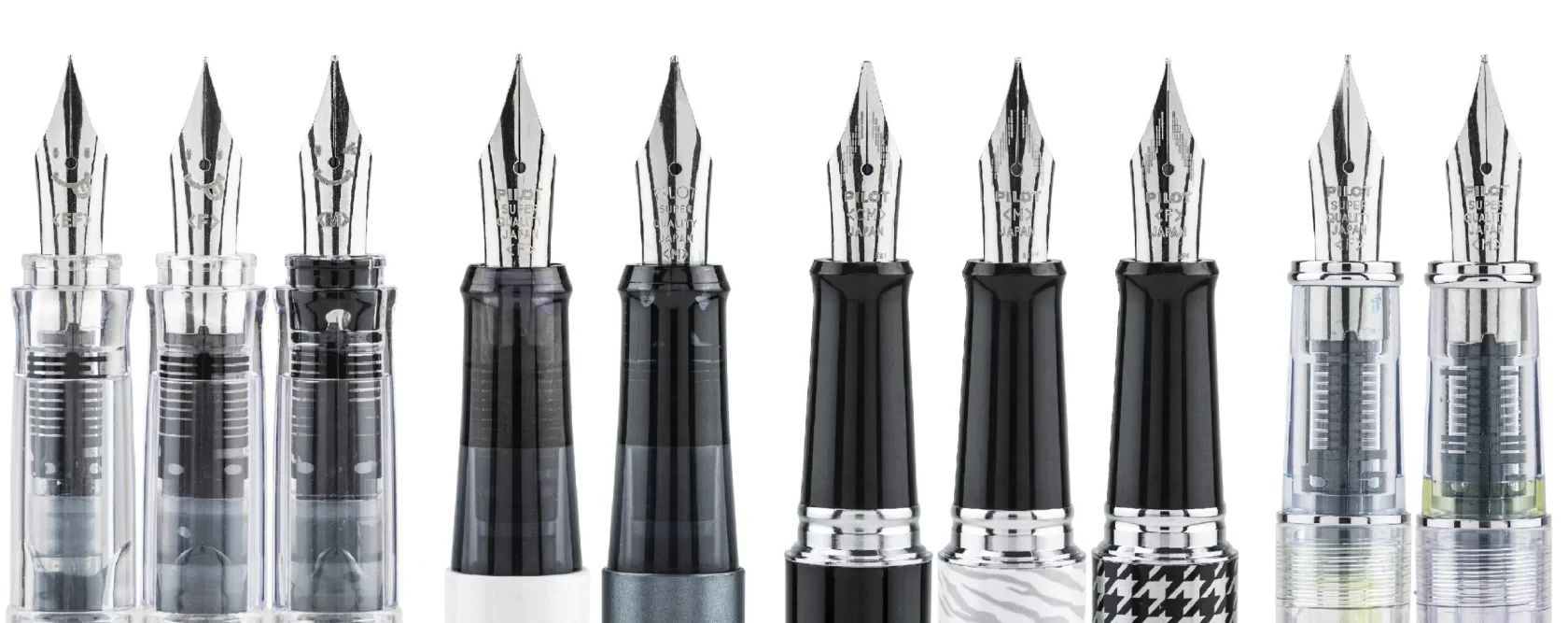
One of the joys of using a fountain pen is the ability to experiment with different inks and fountain pen nibs. Trying out various nib sizes, materials, or even special nibs like oblique, stub, or italic can dramatically change your writing experience. Similarly, switching between different ink colours or types can bring a new dimension to your writing.
Personalising Your Writing Instrument
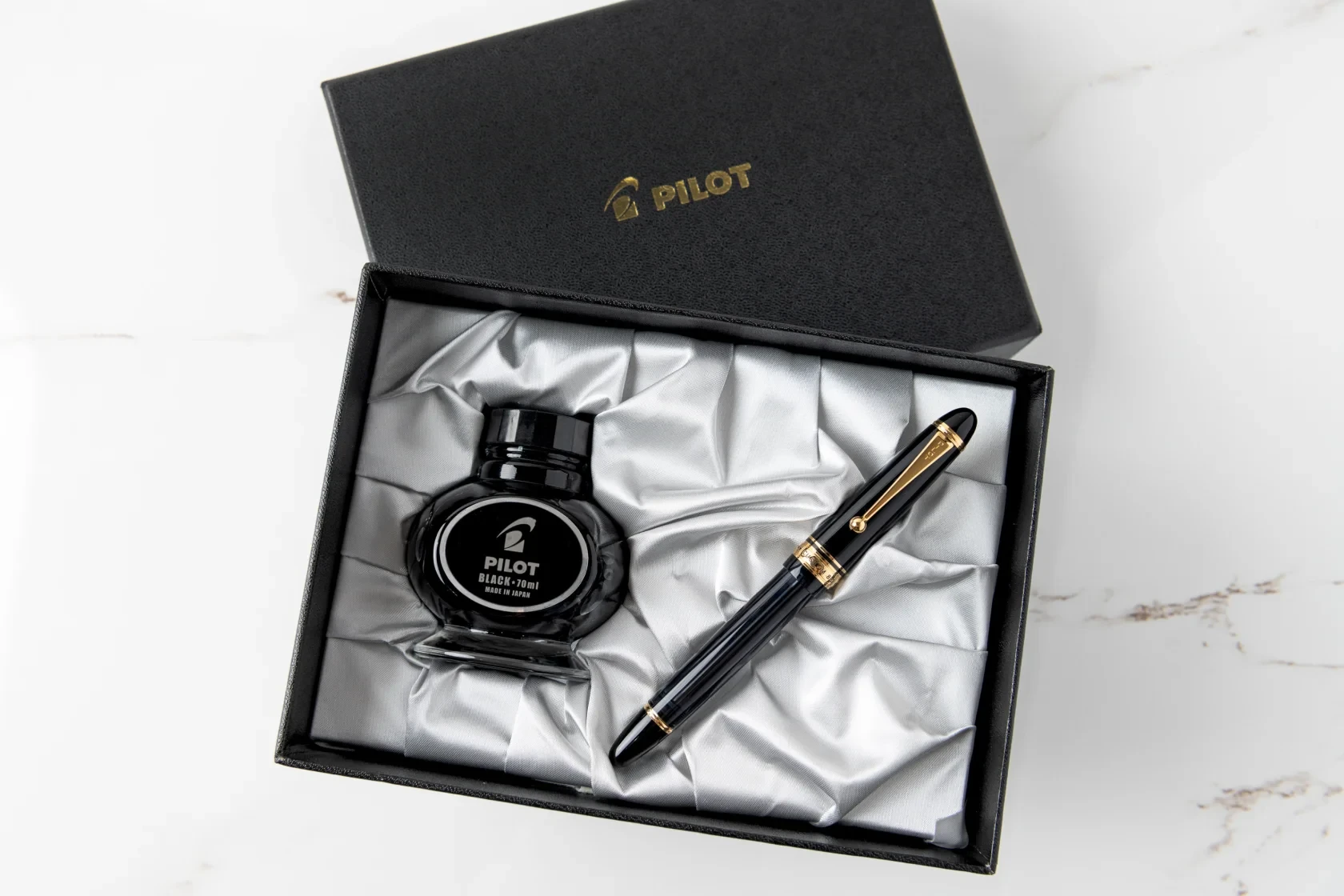
A fountain pen is more than just a writing instrument; it’s an extension of your personality. Personalising your fountain pen with unique materials, colours, finishes, and engravings can add a personal touch to your writing experience.
PILOT offers a range of customisation options that allow you to express your individual style. From the CUSTOM Series which features more modern and classic styles fusing with materials such as ebonite, gold and rhodium, to the CUSTOM Heritage series which offers sophisticated and modern flat-top barrel designs, there's a pen to suit your personal taste.
Whether it’s engraving your initials, choosing a unique pattern or motif, or selecting a material that speaks to you, personalising your pen can make it a cherished item of sentimental value.
Mastering Cursive and Calligraphy
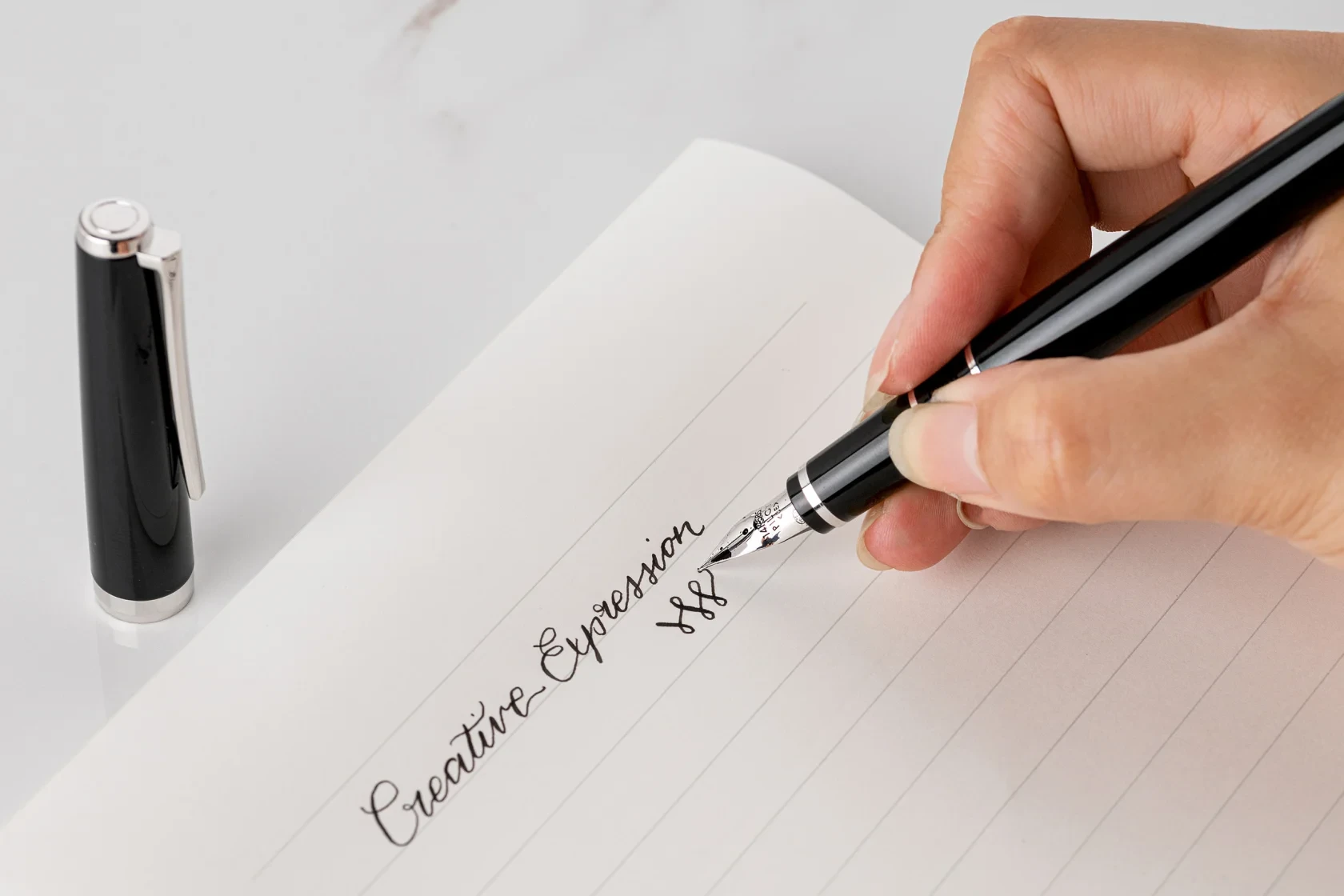
Finally, mastering cursive writing and calligraphy can add an elegant touch to your handwriting. Using broad nibs for cursive writing can produce interesting shading from your ink, while flex and specialty nibs create dynamic line variations in calligraphy by allowing the tines to spread with gentle pressure.
Maintaining a consistent pen angle between 30 to 60 degrees is critical for achieving the ‘thick-and-thin’ effect. Starting with simple letters before progressing to more complex scripts can help establish structure and flow in your handwriting.
Caring for Your Fountain Pen

To ensure your fountain pen writes beautifully for years to come, here are some indispensable maintenance tips. These simple practices will help prevent common issues and maintain your pen's performance. Dive into our comprehensive Fountain Pen Cleaning & Maintenance blog for an in-depth look at each point.
Clean regularly: Flush the nib with soapy water to prevent clogs before refilling your fountain pen.
Store upright: Avoid leaks by keeping your pen nib up.
Skip the extremes: Heat and cold can damage your pen and ink.
Pick the right ink: High-quality ink flows smoothly and protects your pen.
Empty before storage: Clean and empty your pen for long stints. Dried ink is a pain!
Troubleshooting Common Issues
From dried ink to scratchy nibs, fountain pen users may encounter various issues. However, most of these can be resolved with simple troubleshooting techniques. For instance, if a fountain pen hasn’t been used for a while and the ink has dried, cleaning the pen thoroughly with lukewarm water can resolve the issue. For pens that are hard to start after extended non-use, flushing with water and dish soap combined with storing the pen with a small amount of water in the converter or cartridge helps prevent ink from drying.
With a bit of care and maintenance, your fountain pen can provide a lifetime of smooth, satisfying writing when you write with a fountain.
You can find more detailed troubleshooting tips in our Beginner's Guide to Troubleshooting.
The Art of Ink: Colouring Your Words
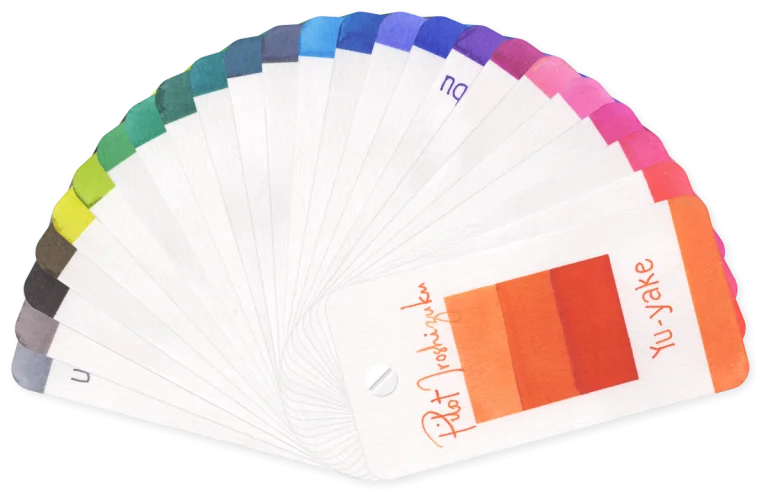
In the realm of fountain pens, ink is not just a medium - it’s an expression of your individuality. The colour, shading, and consistency of your ink can significantly enhance your writing enjoyment and personal expression. One excellent example is PILOT’s iroshizuku inks. Introduced in 2007, these inks were created to be used universally in any pen, nib, or paper, embodying the aesthetic of Japanese culture and enhancing the visual appeal of writing.
With quick drying times and minimal bleed-through, they offer the perfect balance of performance and expression.
Colour as Expression
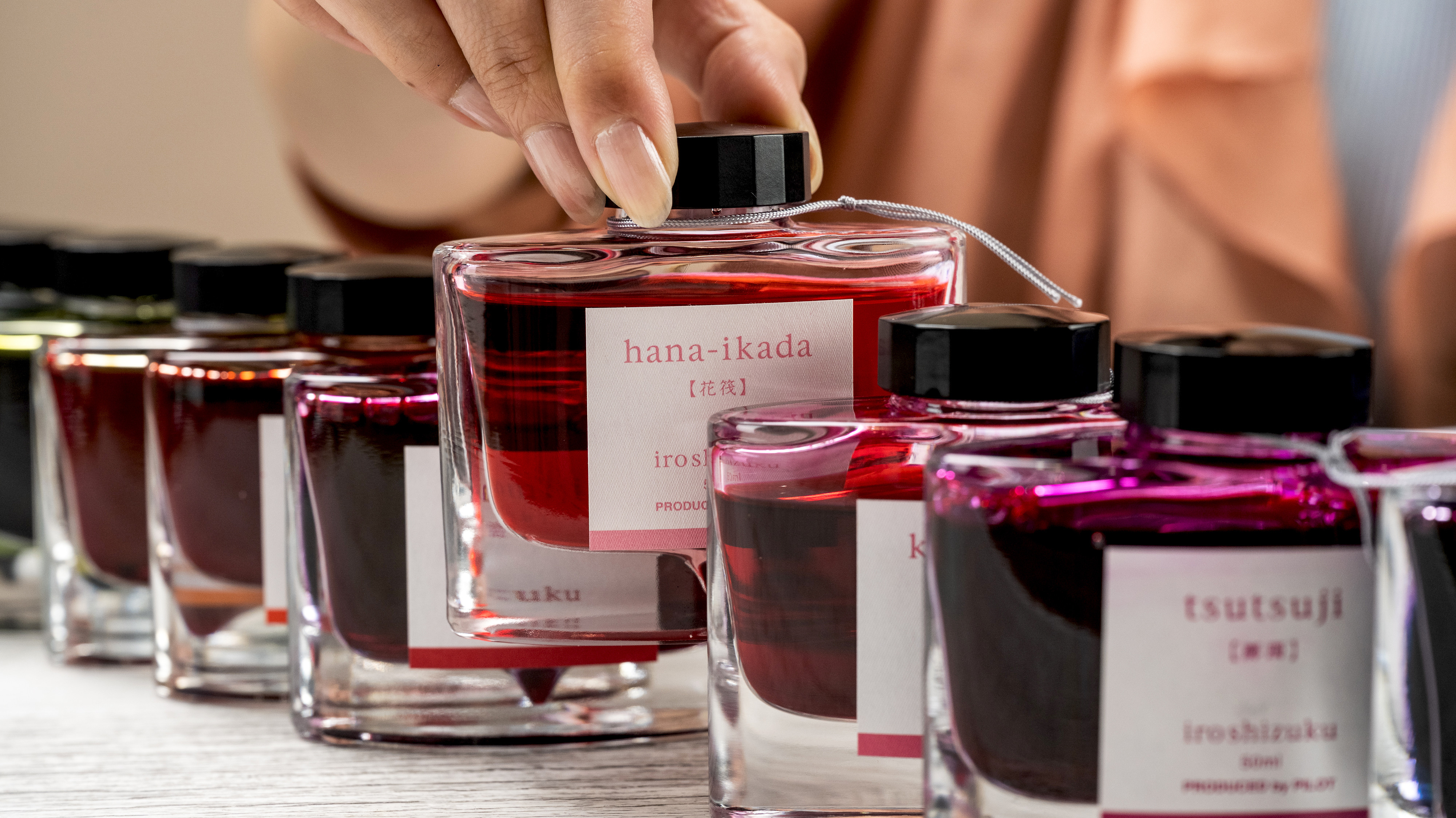
PILOT iroshizuku Fountain Pen Ink range offers a diverse palette of 24 vibrant colours, that are inspired by nature, breaking away from the traditional blue and black ink. Each colour is capable of reflecting a writer’s mood or personality.
For instance, Tsuki-yo and Shin-Kai provide deep blues, representing calmness, while Momiji reveals a vibrant red-pink with a gold sheen, expressing joy and energy. By choosing the right ink colour, you can add an extra layer of personal expression to your writing.
Ink Consistency and Flow
The properties of PILOT iroshizuku Fountain Pen Ink can greatly impact your writing experience. This water-based ink is known for its well-behaved formula that works harmoniously with nibs of all sizes, ensuring a smooth and consistent writing performance. By choosing iroshizuku inks, you can avoid common fountain pen issues such as clogging and enjoy an efficient, uninterrupted ink flow.
Presentation and Packaging
.jpg) Beyond the ink itself, the presentation and packaging of PILOT iroshizuku inks mirror the product's sophistication and allure. The inks are available in various formats to cater to different preferences:
Beyond the ink itself, the presentation and packaging of PILOT iroshizuku inks mirror the product's sophistication and allure. The inks are available in various formats to cater to different preferences:
For those who prefer the convenience of cartridges, the PILOT iroshizuku ink cartridges are a perfect choice, allowing for easy and quick ink replacement.
The traditionalists who enjoy the ritual of refilling from a bottle will appreciate the PILOT iroshizuku bottled inks, available in the full 50ml size for an enduring supply.
And for the enthusiasts looking to sample a spectrum of shades, the PILOT iroshizuku 3 x 15ml gift set offers a curated collection of colours in a beautifully crafted gift box, perfect for gifting or personal exploration.
Each option is presented with the same level of elegance, ensuring that whether you’re refilling your pen at home or on the go, you can do so with style and ease.
Summary
From choosing your first fountain pen, understanding inks and nibs, mastering the writing movement, to proper care and maintenance, the journey of mastering fountain pen writing is a rewarding one. It’s a journey of self-expression, creativity, and a rediscovery of the joy of writing. So, pick up your PILOT fountain pen, choose your favourite iroshizuku ink, and let your words flow onto the page!
Frequently Asked Questions
Can you write normally with a fountain pen?
Yes, you can write normally with a fountain pen just like with a ballpoint or pencil, as they don't require any special technique. Fountain pens may need a lighter touch and some nibs can handle more pressure, but overall, they allow for regular writing.
Why is it hard to write with a fountain pen?
It may be hard to write with a fountain pen due to difficulty in holding it properly for the best writing result, as it should not be gripped tightly like other pens, but held between the thumb and the middle finger a couple of centimetres away from the nib. Fountain pens require a lighter touch which may take some getting used to, but will be beneficial in the long run as it reduces hand fatigue.
Is there a trick to writing with a fountain pen?
When writing with a fountain pen, remember to hold the pen at a 40 to 55-degree angle to allow the ink to flow smoothly. Happy writing!
Why is it important to find the right size and fit when choosing a fountain pen?
It's important to find the right size and fit for your fountain pen to ensure comfortable and balanced writing, preventing strain, especially during long writing sessions. Your hand will thank you!
What are the benefits of experimenting with different inks and nibs?
Experimenting with different inks and nibs can significantly enhance your writing experience by allowing you to vary line thickness and bring new dimensions to your writing with unique ink colours. Try it out and see the difference it makes in your writing!
About Author
Sophia Le
Resident Fountain Pen Fanatic at Pilot Pen Australia.
Capless Collector. Staffy Lover. Casual Gamer and Maker.
Currently a Stardrop Seeker in Stardew Valley after vacationing in Baldur’s Gate and Hyrule.
